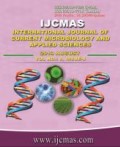


 National Academy of Agricultural Sciences (NAAS)
National Academy of Agricultural Sciences (NAAS)

|
PRINT ISSN : 2319-7692
Online ISSN : 2319-7706 Issues : 12 per year Publisher : Excellent Publishers Email : editorijcmas@gmail.com / submit@ijcmas.com Editor-in-chief: Dr.M.Prakash Index Copernicus ICV 2018: 95.39 NAAS RATING 2020: 5.38 |
The primary objective of this study is to explore fungal pigments as a source for dyeing colorants. Owing to the conflicting reports on the safety of textile and leathers during dyeing and due to the indiscriminate use of non-permitted colors, there is an urgent need to identify natural pigment sources as safe textile colorant. This study critically examines the potentials of fungi as sources production of biocolorant. Along with an established pigment producing fungus, Monascus, newer fungi have been explored and reported. Soil samples from across the various agricultural soils were collected, pigment producing fungi were isolated and characterized. In addition to M. purpureus, potent pigment producing fungal isolates such as Alternaria spp, Fusarium spp, Aspergillus spp and Trichoderma spp were studied to optimize the production technology for pigments. Further, the pigment fractions were analyzed using HPLC, GC-MS and NMR for structure prediction and were found to be anthraquinone (Alternaria spp), di-o-acetyl-lanugon-j (Fusarium spp), Heptacosonic acid 25-methyl ester (Aspergillus spp) and Chrysanthemum hydrolyzed (Tichoderma spp).Compounds which were produced by cultures of M. purpureus, Alternaria spp, Fusarium spp, Aspergillus spp and Trichoderma spp could be used for dyeing cotton with good fastness properties and high dye uptake. Our study showed that natural pigments dyes can provide bright hues and colour fastness properties. They can serve as a noteworthy source of raw material in the future.
 |
 |
 |
 |
 |